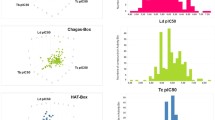Abstract.
Key challenges in antiparasitic drug discovery are target selection and identification of appropriate small molecules as potential ligands for these targets. Novel tools and techniques continue to be developed to address both of these problems. This report focuses on the application of a suite of technologies summarized as combinatorial chemistry. Recent success using these technologies is explored, reasons for frequent failure are given and discussed.





Similar content being viewed by others
References
Aronov AM, Munagala NR, Kuntz ID, Wang CC (2001) Virtual screening of combinatorial libraries across a gene family: in search of inhibitors of Giardia lamblia guanine phosphoribosyltransferase. Antimicrob Agents Chemother 45:2571–2576
Backes BJ, Virgilio AA, Ellman JA (1996) Activation method to prepare a highly reactive acylsulfonamide "safety-catch" linker for solid-phase synthesis. J Am Chem Soc 118:3055–3056
Bressi JC, Verlinde CL, Aronov AM, Shaw ML, Shin SS, Nguyen LN, Suresh S, Buckner FS, Van Voorhis WC, Kuntz ID, Hol WG, Gelb MH (2001) Adenosine analogues as selective inhibitors of glyceraldehyde-3-phosphate dehydrogenase of Trypanosomatidae via structure-based drug design. J Med Chem 44:2080–2093
Carroll CD, Patel H, Johnson TO, Guo T, Orlowski M, He ZM, Cavallaro CL, Guo J, Oksman A, Gluzman IY, Connelly J, Chelsky D, Goldberg DE, Dolle RE (1998) Identification of potent inhibitors of Plasmodium falciparum plasmepsin II from an encoded statine combinatorial library. Bioorg Med Chem Lett 8:2315–2320
Golisade A, Bressi JC, Van Calenbergh S, Gelb MH, Link A (2000) Polymer-assisted solution-phase synthesis of 2′-amido-2′-deoxyadenosine derivatives targeted at the NAD+-binding sites of parasite enzymes. J Comb Chem 2:537–544
Golisade A, Herforth C, Quirijnen L, Maes L, Link A (2002) Improving an antitrypanosomal lead applying nucleophilic substitution on a safety catch linker. Bioorg Med Chem 10:159–165
Huang L, Lee A, Ellman JA (2002) Identification of potent and selective mechanism-based inhibitors of the cysteine protease cruzain using solid-phase parallel synthesis. J Med Chem 45:676–684
Kehoe JW, Maly DJ, Verdugo DE, Armstrong JI, Cook BN, Ouyang YB, Moore KL, Ellman JA, Bertozzi CR (2002) Tyrosylprotein sulfotransferase inhibitors generated by combinatorial target-guided ligand assembly. Bioorg Med Chem Lett 12:329–332
Kennedy KJ, Bressi JC, Gelb MH (2001) A disubstituted NAD+ analogue is a nanomolar inhibitor of trypanosomal glyceraldehyde-3-phosphate dehydrogenase. Bioorg Med Chem Lett 11:95–98
Lipinski C, Lombardo F, Dominy B, Feeney P (1997) Experimental and computational approaches to estimate solubility and permeability in drug discovery and development settings. Adv Drug Deliv Rev 46:3–25
McGovern SL, Caselli E, Grigorieff N, Shoichet BK (2002) A common mechanism underlying promiscuous inhibitors from virtual and high-throughput screening. J Med Chem 45:1712–1722
Otto S, Furlan RL, Sanders JK (2002) Dynamic combinatorial chemistry. Drug Discov Today 7:117–125
Pitcovsky TA, Mucci J, Alvarez P, Leguizamon MS, Burrone O, Alzari PM, Campetella O (2001) Epitope mapping of trans-sialidase from Trypanosoma cruzi reveals the presence of several cross-reactive determinants. Infect Immun 69:1869–1875
Reents R, Jeyaraj DA, Waldmann H (2002) Enzymatically cleavable linker groups in polymer-supported synthesis. Drug Discov Today 7:71–76
Ring CS, Sun E, McKerrow JH, Lee GK, Rosenthal PJ, Kuntz ID, Cohen FE (1993) Structure-based inhibitor design by using protein models for the development of antiparasitic agents. Proc Natl Acad Sci U S A 90:3583–3587
Roche O, Schneider P, Zuegge J, Guba W, Kansy M, Alanine A, Bleicher K, Danel F, Gutknecht EM, Rogers-Evans M, Neidhart W, Stalder H, Dillon M, Sjogren E, Fotouhi N, Gillespie P, Goodnow R, Harris W, Jones P, Taniguchi M, Tsujii S, von der Saal W, Zimmermann G, Schneider G (2002) Development of a virtual screening method for identification of "frequent hitters" in compound libraries. J Med Chem 45:137–142
Scharn D, Wenschuh H, Reineke U, Schneider-Mergener J, Germeroth L (2000) Spatially addressed synthesis of amino- and amino-oxy-substituted 1, 3,5-triazine arrays on polymeric membranes. J Comb Chem 2:361–369
Smith HK, Bradley M (1999) Comparison of resin and solution screening methodologies in combinatorial chemistry and the identification of a 100 nM inhibitor of trypanothione reductase. J Comb Chem 1:326–332
St Hilaire PM, Alves LC, Sanderson SJ, Mottram JC, Juliano MA, Juliano L, Coombs GH, Meldal M (2000) The substrate specificity of a recombinant cysteine protease from Leishmania mexicana: application of a combinatorial peptide library approach. Chembiochem 1:115–122
Suresh S, Bressi JC, Kennedy KJ, Verlinde CL, Gelb MH, Hol WG (2001) Conformational changes in Leishmania mexicana glyceraldehyde-3-phosphate dehydrogenase induced by designed inhibitors. J Mol Biol 309:423–435
Verlinde CL, Callens M, Van Calenbergh S, Van Aerschot A, Herdewijn P, Hannaert V, Michels PA, Opperdoes FR, Hol WG (1994) Selective inhibition of trypanosomal glyceraldehyde-3-phosphate dehydrogenase by protein structure-based design: toward new drugs for the treatment of sleeping sickness. J Med Chem 37:3605–3613
Author information
Authors and Affiliations
Corresponding author
Rights and permissions
About this article
Cite this article
Link, A. Combinatorial chemistry as a new approach in antiparasitic drug discovery. Parasitol Res 90 (Suppl 2), S86–S90 (2003). https://doi.org/10.1007/s00436-002-0772-7
Published:
Issue Date:
DOI: https://doi.org/10.1007/s00436-002-0772-7




